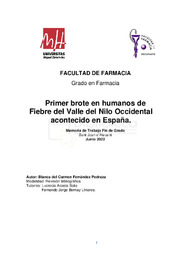Por favor, use este identificador para citar o enlazar este ítem:
https://hdl.handle.net/11000/28350Registro completo de metadatos
| Campo DC | Valor | Lengua/Idioma |
|---|---|---|
| dc.contributor.advisor | Acosta Soto, Lucrecia | - |
| dc.contributor.advisor | Bornay Llinares, Fernando Jorge | - |
| dc.contributor.author | Ferrández Pedraza, Blanca del Carmen | - |
| dc.contributor.other | Departamentos de la UMH::Agroquímica y Medio Ambiente | es_ES |
| dc.contributor.other | Departamentos de la UMH::Salud Pública, Historia de la Ciencia y Ginecología | es_ES |
| dc.date.accessioned | 2022-11-15T09:30:50Z | - |
| dc.date.available | 2022-11-15T09:30:50Z | - |
| dc.date.created | 2022-05-21 | - |
| dc.identifier.uri | https://hdl.handle.net/11000/28350 | - |
| dc.description.abstract | Introducción: El Virus del Nilo Occidental es un arbovirus zoonótico, que se transmite al ser humano desde su reservorio animal (las aves) mediante artrópodos, principalmente mosquitos, del género Culex sp. La clínica en humanos varía desde asintomática (aproximadamente 80% de las infecciones) hasta meningitis, encefalitis, parálisis flácida o muerte (menos del 1% de las infecciones). En España, se habían detectado casos esporádicos de infecciones humanas desde 2007, pero en los últimos años, se ha manifestado en forma de brotes y epidemias con multitud de casos graves, siendo una amenaza para la salud pública, humana y animal. Objetivo: Describir los últimos brotes de virus del Nilo Occidental en humanos ocurridos en España en los años 2020 y 2021. Métodos: Se ha realizado una revisión bibliográfica sobre el tema a tratar. Para ello, se revisaron distintas fuentes de información, como artículos, páginas web oficiales y bases de datos. Resultados y Discusión: Los últimos brotes humanos causados por el virus del Nilo Occidental en España registraron un total de 77 casos de meningoencefalitis en 2020, de los que 8 tuvieron un desenlace fatal, y 3 casos en 2021. Todos los casos humanos estudiados fueron causados por el linaje 1 del virus. Las provincias de Sevilla, Cádiz y Badajoz fueron las más afectadas. Las especies de mosquitos predominantes en las zonas afectadas durante las dos temporadas fueron Culex perexiguus y en menor proporción Culex pipiens. Conclusiones: España hoy día presenta una situación endémica de la enfermedad del virus del Nilo Occidental debido a que reúne las condiciones idóneas para el mantenimiento y circulación del virus. En la actualidad no existen medicamentos antivirales específicos ni vacunas para humanos, aunque sí para équidos. Las medidas de control frente al virus se basan en la vigilancia epidemiológica, crear conciencia sobre los factores de riesgo y educar a los ciudadanos sobre cómo actuar frente al virus. | es_ES |
| dc.description.abstract | Introduction: West Nile Virus (WNV) is a zoonotic arbovirus that is transmitted to humans from its animal reservoir (birds) by arthropods, mainly mosquitoes, of the genus Culex sp. The clinic in humans varies from asymptomatic (approximately 80% of infections) to meningitis, encephalitis, flaccid paralysis, or death (less than 1% of infections). In Spain, sporadic human cases had been detected since 2007, but in recent years, it has manifested itself in the form of outbreaks and epidemics with many serious cases, posing a threat to public, human and animal health. Objective: To describe the latest outbreaks of West Nile virus in humans that occurred in Spain in the years 2020 and 2021. Methods: A bibliographic review on the subject to be treated has been carried out. For this, different sources of information were reviewed, such as official websites, databases, and newspapers. Results and Discussion: The last human outbreaks caused by WNV in Spain registered a total of 77 cases of meningoencephalitis in 2020, of which 8 had a fatal outcome, and 3 cases in 2021. All the human cases studied were caused by the lineage 1 of the virus. The provinces of Seville, Cádiz and Badajoz were the most affected. The predominant mosquito species in the affected areas during the two seasons were Culex perexiguus and, to a lesser extent, Culex pipiens. Conclusions: Spain today presents an endemic situation of WNV disease because it meets the ideal conditions for the maintenance and circulation of the virus. Currently there are no specific antiviral drugs or vaccines for humans, although there are for horses. Control measures against the virus are based on epidemiological surveillance, raising awareness about risk factors and educating citizens on how to act against the virus. | es_ES |
| dc.format | application/pdf | es_ES |
| dc.format.extent | 40 | es_ES |
| dc.language.iso | spa | es_ES |
| dc.publisher | Universidad Miguel Hernández de Elche | es_ES |
| dc.rights | info:eu-repo/semantics/openAccess | es_ES |
| dc.rights.uri | http://creativecommons.org/licenses/by-nc-nd/4.0/ | * |
| dc.subject | VNO | es_ES |
| dc.subject | Flavivirus | es_ES |
| dc.subject | Arbovirus | es_ES |
| dc.subject | Epidemiología | es_ES |
| dc.subject | Fiebre del Nilo Occidental | es_ES |
| dc.subject.other | CDU::6 - Ciencias aplicadas | es_ES |
| dc.title | Primer brote en humanos de Fiebre del Valle del Nilo Occidental acontecido en España. | es_ES |
| dc.type | info:eu-repo/semantics/bachelorThesis | es_ES |

Ver/Abrir:
Ferrández Pedraza Blanca del Carmen.pdf
1,75 MB
Adobe PDF
Compartir:
 La licencia se describe como: Atribución-NonComercial-NoDerivada 4.0 Internacional.
La licencia se describe como: Atribución-NonComercial-NoDerivada 4.0 Internacional.
.png)